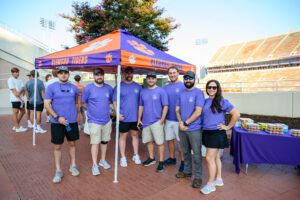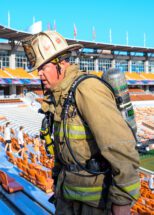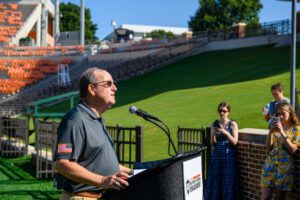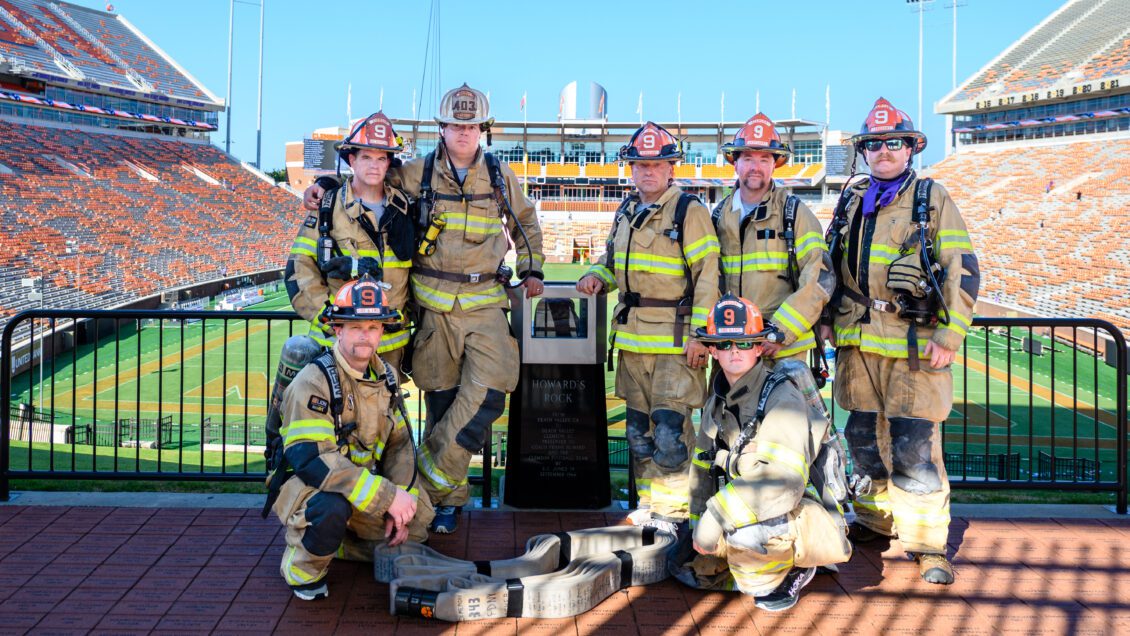Clemson University held a remembrance event on Monday, Sept. 11 inside of Memorial Stadium. Approximately 200 students, faculty, staff, affiliates and guests came together on a humid morning to honor first responders and all whose lives were lost in the 9/11 terrorist attacks by climbing stairs and walking the concourse of Clemson’s famed football stadium.
“We wanted to honor those who lost their lives on 9/11 and connect it to Clemson in a way that would be meaningful for everyone involved,” says Chase Carter, a senior work-study student in the Military & Veteran Resource Center and veteran of the United States Marine Corps.

Following a welcome from Military & Veteran Engagement staff and singing of the national anthem, participants ascended the steep aisles of the stadium, walking up every other portal of the south and north stands — some for the better part of two hours — in alignment with the timeline of events from 9/11.
Event staff handed out bottles of water to keep participants hydrated. Names of those whose lives were lost scrolled the massive videoboard in the stadium. Dozens of thank-you notes were written for area first responders, including those in Clemson University Public Safety. News cameras from local TV stations captured live interviews with veterans, planners and participants.
When the walk concluded at roughly 10:30 a.m., those remaining gathered for a 21-gun salute performed by the Pershing Rifles and the playing of TAPS.
CUFD members gear up, take part in stair climb
Ben Crenshaw serves as the C-shift captain for Clemson University Fire & EMS and has been with the department for about 20 years. Prior to his time at Clemson, he served in the Marine Corps and worked at the Pentagon for two and a half years.

Monday’s event took on additional meaning to Crenshaw, who remembers exactly where he was during the 9/11 attacks.
“I was working for my family business at the time, but still had friends who worked at the Pentagon,” he says. “I spent most of the day trying to make contact with everyone.”
Crenshaw was one of seven members of CUFD to participate in Monday’s stair climb. The group walked in full firefighting gear and rotated carrying a heavy water hose — making temperatures inside their uniforms feel closer to 100 degrees.
“It’s about pushing through and sacrificing the pain for the bigger cause,” he says. “As soon as we heard about this event, a bunch of us jumped at the opportunity to honor those who died on 9/11.”
Fire inspector Craig Walters ended up dropping his gear and completing a second circuit around the lower bowl, equating to roughly the 110 flights of stairs first responders climbed to reach the top floor of the World Trade Center towers on Sept. 11, 2001.
“So many paid the ultimate sacrifice that day … the least I can do is come out here and sweat a little bit.”
9/11 attacks hit close to home for Morrow
Monday’s event concluded with remarks from Major General Hank Morrow (Ret.), who was serving in two different capacities at the time of the 9/11 attacks — commander of the 149th Fighter Wing in San Antonio, Texas and captain for American Airlines based out of Dallas Forth Worth (DFW) International.
He spoke at length about how both of his roles had profound effects in the aftermath of 9/11.

“American Airlines lost 17 crew members that day,” recalls Morrow, a 1977 Clemson graduate and current executive secretary to Clemson’s Board of Trustees. “Of the four pilots, three were military — two from the Navy and one from the Air Force. And it was the same with the United Airlines pilots who were lost. You can imagine the emotional toll it took on me.”
He later shared a story of Charles “Chic” Burlingame, a Naval Academy graduate and former military pilot, who — like Morrow — was serving as a commercial airline pilot on 9/11. The plane he was piloting was hijacked and crashed into the Pentagon, leaving 189 dead.
At the time, Burlingame was not able to be interred at Arlington National Cemetery. Morrow joined a host of others and petitioned Congress for his burial, and it was ultimately approved.
“If you tour the cemetery today, you’ll see buried presidents and four-star generals … and you’ll also see where Chic is buried,” says Morrow, holding back tears. “On top of his tombstone is a piece of the Pentagon, the only such tombstone allowed at Arlington.
“Two-thousand, nine hundred and seventy-seven people died that day. We should never forget their sacrifices.”
Editor’s Note: Special thanks to 9/11 remembrance organizers and supporters from Military & Veteran Engagement, Student Veterans Association, Upstate Warrior Solution, Clemson Corps, Tiger Platoon, Military Council, Pershing Rifles and Sigma Alpha Epsilon.

